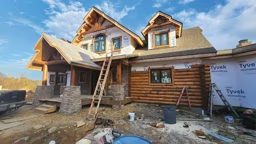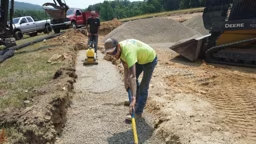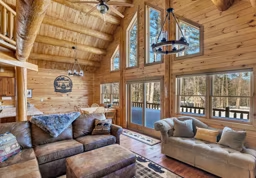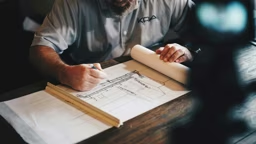_11868_2023-04-27_10-18.jpg)
Sand Creek Post & Beam photo
What does living off the grid mean to you?
autonomous, providing for all of life’s necessities from supplying their own food to providing a power source. For most, however, the term simply refers to achieving total (or at least partial) energy independence.
So, the question is: What do you need to do to unplug from public utilities and still operate your household effectively and comfortably?
In seeking to answer this question, many buyers get hung up on researching what “the best” alternative energy source is, and, all too often, they ignore the most important thing: ensuring that the house, itself, is built to be energy efficient.
When I’m talking to clients who want to live off the grid, I don’t start by inquiring how they want to generate fuel for the house. I begin by asking how we can design and build the house to reduce power consumption to minimize the need for energy. Once we accomplish that, we can look at what the remaining energy requirements are and determine what products we can use or tactics we can take not only to supply the necessary energy, but continue to decrease demand and the resulting expenses.
Built-In Benefits
We’re fortunate that in today’s market we have a host of materials available to help us reach our energy goals. Things like structural insulated panels (SIPs), which offer continuous solid-core insulation, and aerobarriers, which can seal structural gaps as thin as a human hair, tighten a home’s thermal envelope.Low-e and gas-filled windows greatly enhance overall energy performance, and radiant in-floor heat is an excellent, ductless way to warm a house. It’s also essential, particularly with a log or timber frame structure, that the house be properly constructed by a qualified, experienced builder according to the log or timber frame producer’s directions. There are unique factors in log and timber home erection, joinery and sealing that a knowledgeable builder knows how to properly address, and this experience is invaluable.
Once the house is built and outfitted to perform to its peak efficiency, the demand for power becomes less, but you still need to understand what your daily energy usage will be in order to choose the proper source. Examine your current lifestyle patterns and determine how you use energy, and then look for ways you can reduce that usage.
Obviously, the biggest energy requirement in a temperate climate lies in heating and cooling the house. Depending on where you live, in summer, you’re likely running the air conditioner rigorously, and in winter, you’re burning some type of fuel, whether it’s natural gas, propane, wood or electricity. Conditions and personal preferences will drive the type of HVAC product you choose.
Other appliances, especially the refrigerator and hot-water heater, guzzle energy, too, so electing to buy Energy Star-rated units will help cut that back. You can consider an on-demand system, which will warm the water more efficiently than a huge 60-gallon-capacity standard water heater; however, to be off the grid, these units require a propane tank to heat the water fast, and that may not be the path you’re pursuing. Even switching to LED light bulbs, which use 75 percent less energy than the incandescent variety, will help lower daily power consumption.
So, yes, once you’ve conducted this self-audit, you likely can remove yourself from the municipal power grid by choosing one of a variety of alternative-energy sources. On this front, it’s important to go with an option that makes sense for the area in which you live.
For example, if your house is located in a place that doesn’t get consistent, direct sunshine, then solar probably isn’t the way to go. Likewise, don’t set your heart on a wind turbine if you live in an area that’s habitually stagnant. You’ll just be setting yourself up for failure and some level of dependence on outside energy sources.
Nothing is Free, But the Savings are Real
Let’s be clear: No matter what route you go, energy costs money. There’s a misconception that alternative energy is “free.” There is no such thing. There will be expenses, regardless of whether you’re getting it from a power company, buying a solar-panel array, developing a hydro-power system from a nearby body of water, maintaining a wind turbine or refueling a propane tank. Then, there are costs of implementation and operation to supply the power to the house. You may not pay a monthly bill anymore (and that’s a great advantage), but alternative energy is not a “get-it-and-forget-it” proposition.That said, there are savings to be had. The average cost to connect to municipal power is $10,000 — just for the privilege of tapping into the grid. Then, of course, you have the monthly bill on top of that.
By contrast, a residential solar array can cost anywhere from $15,000 to $40,000 (before tax credits or incentives), depending on the size of the home; plus, you will need a battery storage unit to retain the solar energy you generate. But once installed, you won’t have monthly fees. However, you’d be wise to have a redundant system, like a propane tank with a backup generator, in case the solar array fails or the power supply becomes limited because of weather conditions. This will cost extra in setup and fuel.
Geothermal systems are increasingly popular, and costs have come down over the past few years. Geothermal uses the same ducts and air handlers inside the home as a forced-air system. The additional cost comes in the form of the trenches and/or wells you dig and the pipeline that’s required based on the square footage of the home. For a three- to four-bedroom house, you’re adding roughly $15,000 to $18,000 on top of a standard HVAC system to engage geothermal energy as your power source. That said, one major benefit to justify the extra cost is that the ground below the frost line is consistent (60 degrees on average) regardless of season, and the geothermal system pulls from that, rather than combat shifting outside-air temperatures.
So, what’s the bottom line? The more efficient your home is, the less power you’ll use — and the easier it will be for you to move your daily household operation needs off the grid. Not only will you achieve a return on your investment, but you’ll gain true energy independence as well.
Bonus Tip: Don’t Touch That Dial
If you’re someone who raises/lowers the temperature when you’re not home, you’re wasting energy and money. To compensate for the fluctuations, your HVAC unit will have to work double time to achieve your desired, livable temp when you’re there. Keeping your thermostat at one consistent degree is much more energy efficient than constantly adjusting it.About the Author
Dan Mitchell is a builder and a Log & Timber Home University professor. He owns Eagle CDI, a construction firm based near Knoxville, Tennessee.
Learn more about going off-grid here:











